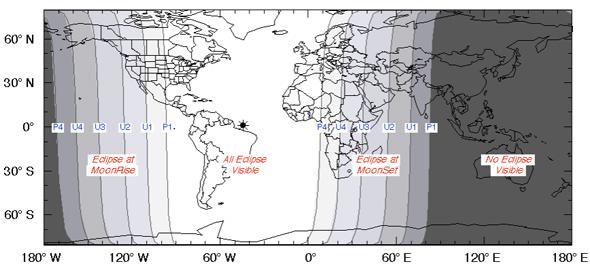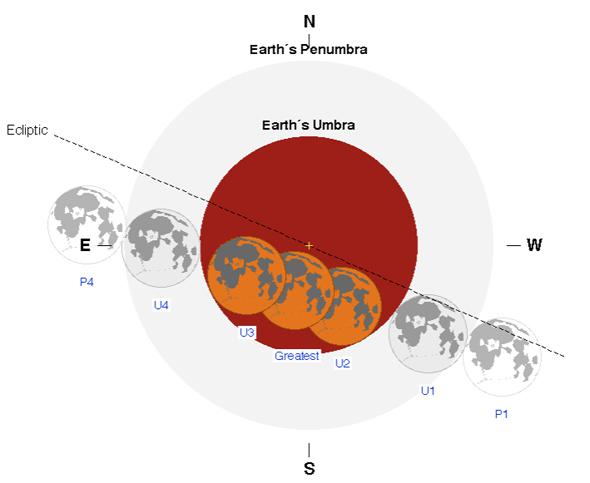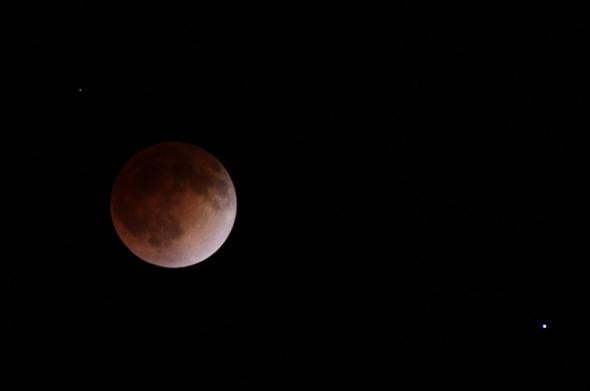On Sept. 27 and 28, the Moon will enter Earth’s shadow, creating a total lunar eclipse. These only happen a couple of times a year, and are a great event to watch.
First, the quick stuff you need: The Moon begins to enter the dark part of Earth’s shadow starting at 01:07 UTC on Sunday night/Monday morning. To be clear, for folks in the U.S. that’s Sunday night, starting at 9:07 p.m. Eastern time; for most of the country the Moon will be low to the eastern horizon. At that time you’ll start to see a dark “bite” taken out of the Moon on the part of it nearest the horizon (the lower left, again for Americans).
It’ll take just over an hour for the Moon to pass fully into the shadow, and the last sliver of it will slip into darkness at 02:11 UTC (10:11 Eastern). It’ll stay dark for more than an hour, and then start to be illuminated once again at 03:23 UTC (11:23 Eastern). “Last contact,” when it is out of Earth’s shadow, occurs at 04:27 UTC (00:27 Eastern, after midnight).
People in the western U.S. (west of Colorado) will see the Moon already in eclipse when it rises. Here’s a map to show if you’ll be able to view the eclipse:

Drawing by NASA/Fred Espenak
“U1” is when the Moon begins to enter the dark part of the shadow (the umbra), so everyone east of that spot in the U.S. will see the whole eclipse. Everyone west of the line marked “U4” (when the last part of the Moon leaves the shadow) will miss the event. Sorry. We live on an opaque spinning planet, so someone always misses out. Anyway, the diagram below shows the Moon’s path through the Earth’s shadow.

Drawing by NASA/Fred Espenak
You don’t need any special equipment to see this; just go outside and look at the Moon. (This is different than a solar eclipse, where you need eye protection from the bright Sun.) Having said that, I’ve always found binoculars to be best aid to viewing. The Moon can take on an odd three-dimensional appearance when you use binoculars during an eclipse, and it’s pretty cool to see. A telescope is great, too, if you have access to one. If there’s a local astronomy club or observatory near you, see if they’re running a star party for it.
I’ve written before about exactly how and why we get lunar eclipses; the dance of the Moon, Earth, and Sun has to play out just right for the Moon to move through Earth’s shadow in the sky. Go there to get details, but there’s one thing I want to emphasize.
When the Moon is fully eclipsed it usually turns red, though sometimes the effect is more subtle than other times. This is because from the Moon’s point of view the Earth is blocking the Sun, and sunlight gets filtered through the thin layer of Earth’s atmosphere, reddening it. If you were standing on the Moon, it’s like you’re seeing every sunrise and sunset on Earth all at once!
How about that?
You can read more about the eclipse at the Time and Date site, EarthSky (which separately lists the timing for the eclipse in different U.S. local time zones), and Wikipedia. Also, the Virtual Observatory will be running a live viewing of the event online, in case your weather isn’t cooperative. So will my friend Adam Block at the Mt. Lemmon SkyCenter.
Also, I just so happen to have done an entire episode of Crash Course Astronomy on eclipses. Watch!
I’ll note that this eclipse happens very close to when the Moon is at perigee, the part of its elliptical orbit when it’s closest to Earth. Its average distance from Earth (center to center) is about 384,000 kilometers, and during the eclipse it’ll be only 356,900 km distant, 7 percent closer than average. That means it’ll look 7 percent wider than average … but I doubt you’ll notice. If you took a picture when it’s at apogee (farthest from Earth) on Sept. 14—when it’s 406,500 km away—and then compared it with a picture taken on Sept. 28 you’d definitely see the difference! But just going out and looking during the eclipse you’re unlikely to be able to tell.
Of course, the Moon will be rising for many people in the U.S. at the start of the eclipse, so the Moon may look huge due to the well-known Moon Illusion. But don’t be fooled! A lot of websites will no doubt be hyping up the “Supermoon” (a full Moon at or near perigee), but don’t be taken in by them. The difference in size isn’t all that much.
Not to pooh-pooh any of this! Lunar eclipses are fun; they play out relatively slowly, so you can take a look, go inside for a few minutes, then go back outside to see more of the Moon gone. It’s a great opportunity to try your photography skills, and because you don’t need any equipment, it’s nice to get friends and family together outside to take a peek.
I strongly recommend marking your calendar. The next total lunar eclipse won’t happen until January 2018! So watch this one if you can.
